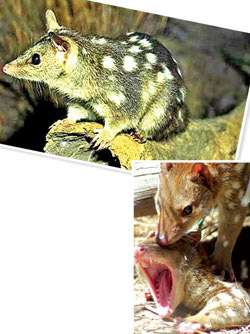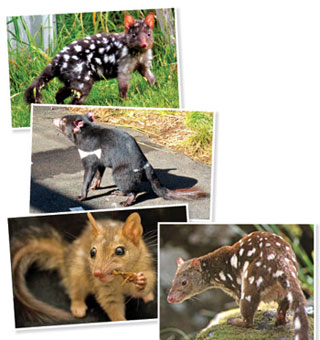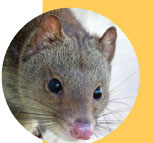Quolls........
carnivorous marsupials:
Is it a cat or a rat? It is neither. The quoll also called a native
cat is a carnivorous marsupial which lives in Australia and New
Guinea.This cat- like creature belongs to the the family Dasyuridae,
which includes most carnivorous marsupial mammals. It is usually found
in the forests but due to deforestation, loss of habitat and predation
by introduced animals such as the fox and also toxic cane toads,it has
disappeared from many parts of the Australian mainland .
 The tribe Dasyurini to which the quoll belongs also includes the
Tasmanian devil, antechinuses, the Kowari, and mulgaras. Within the
genus Dasyurus, the following species exist;, Western Quoll or Chuditch
, Northern Quoll (in tropical north Queensland), Tiger Quoll or Spotted
Quoll, (along the east coast) and Eastern Quoll also called the
Tasmanian Quoll (found only in Tasmania). These four species are found
in Australia and the New Guinean Quoll and the Bronze Quoll in Papua New
Guinea.The difference between these four main species is minimal . The tribe Dasyurini to which the quoll belongs also includes the
Tasmanian devil, antechinuses, the Kowari, and mulgaras. Within the
genus Dasyurus, the following species exist;, Western Quoll or Chuditch
, Northern Quoll (in tropical north Queensland), Tiger Quoll or Spotted
Quoll, (along the east coast) and Eastern Quoll also called the
Tasmanian Quoll (found only in Tasmania). These four species are found
in Australia and the New Guinean Quoll and the Bronze Quoll in Papua New
Guinea.The difference between these four main species is minimal .
These small, furry animals with white spots are between 25 and 75
centimetres (30 in) long, with hairy tails about 20 to 35 centimetres
(14 in) long. The females have six to eight nipples and develop a pouch
“ which opens towards the tail” only during the breeding season, when
rearing young. When the young are born they are the size of a grain of
rice. They attach themselves to their mother's nipples to drink her
milk. They go everywhere with the mother.
Quolls live in both forests and in open valley land. Though primarily
ground-dwelling, they have developed secondary arboreal characteristics.
They do not have prehensile tails , but do have ridges on the pads of
their feet,to walk the rough ground. Their molars and canines are
strongly developed. They feed on small animals, plants, lizards, birds,
insects, fruit and carrion (dead animals). The big brown eyes are well
adapted to see in the dark.
The Western Quoll or Chudditch can be found in the Jarrah Forest
located in south Western Australia. The population of the species in
that location is estimated at 3,000 animals. This species is regarded as
the largest marsupial predator found in Western Australia.The tail
accounts for nearly half of the total body measurement of the chudditch.
The head and body average about 330mm, with the tail averaging 280mm in
length.The tail has thin (lacking density) fur that is a grey tan colour
that fades into a black on the bottom half. This species can weigh as
much as two kg, females weigh less than males. Olive grey fur with white
spots covers the body of the Chudditch. . There is creamy white fur on
the underbelly of the Chudditch.
 The Tiger Quoll is mainland Australia's largest, and the world's
longest (the biggest is the Tasmanian Devil), living carnivorous
marsupial and it is considered an apex predator. It ranges from 35 to 75
cm in length and has a tail of about 34 to 50 cm. The Tiger Quoll is mainland Australia's largest, and the world's
longest (the biggest is the Tasmanian Devil), living carnivorous
marsupial and it is considered an apex predator. It ranges from 35 to 75
cm in length and has a tail of about 34 to 50 cm.
It is also very much larger than other species of quolls. Females are
smaller than the males: while females grow to four kilograms, males can
reach up to seven kg.
It has thick, soft fawn, brown or black fur but the fur on the
underside is much lighter. Small white spots cover not only the body but
also its bushy tail, which may also have a white tip.The snout is
pointed and sports a moist pink nose.It has bright eyes and sharp teeth.
This quoll feeds on a large range of prey including: insects, birds
and small animals such as rats and mice.It is a good climber but spends
most of its time on the forest floor. Even though it is a nocturnal
animal it spends the daylight hours basking in the sun.
It nests in rocky banks, hollow logs, or small caves.It produces one
litter a year with four to six young. The gestation period is about
three weeks. The young remain in their mother's pouch for about seven
weeks, and it takes some 18 weeks for them to become independent of the
mother.
The tiger quoll can reach an age of up to 4 or 5 years.The northern
subspecies of the tiger quoll lives in restricted areas around Cairns
and Cooktown in northern Queensland, and also in Papua New Guinea. It is
slightly smaller than the southern subspecies. It is predicted that only
50 per cent of quolls remain compared to last century.
The Eastern Quoll which once inhabited mainland Australia is now
considered extinct on the mainland, with the last sighting occuring in
the Sydney suburb of Vaucluse in the early 1960s. However, some recent
sightings in the New England region of northern New South Wales suggest
that the species may still survive.
The males are about the size of a small domestic cat averaging 60 cm
in length and 1.3 kg in weight; females are slightly smaller. They have
soft fur that is coloured fawn, brown or black. There are small white
spots cover the body but not on the bushy tails, which may have a white
tip.
Compared to the related spotted-tail quoll, the eastern quoll is
slightly built with a pointed muzzle.The species, fortunately, is
widespread and locally common in Tasmania.
The eastern quolls are largely solitary. They hunts and scavenge,
feeding largely on insects. Eastern quolls are nocturnal and only
occasionally forage or bask during daylight. During the day they sleep
in nests made under rocks in underground burrows or fallen logs. Like
the spotted-tail quoll, the eastern quoll is an opportunistic carnivore
that takes live prey and scavenges.The Eastern quoll is an impressive
hunter, taking small mammals such as rabbits, mice and rats. Eastern
quolls sometimes scavenge morsels of food from around feeding Tasmanian
devils. However,its main diet is invertebrates, especially agricultural
pests. Carrion and some fruits are also eaten. Breeding occurs in early
winter. Predation and direct competition potentially force the eastern
quoll from its natural habitat. The threat from foxes, dogs, road kills,
landowners, and illegal poisoning or trapping, are also causing
declines. The species is wholly protected by law.
 The Northern Quoll is a medium-sized carnivorous marsupial that lives
in the savannas of northern Australia. It is found from southeastern
Queensland all the way to the northern Western Australian (WA) coast.
Populations have declined across much of this range, particularly as a
result of the spread of the cane toad. The Northern Quoll is a medium-sized carnivorous marsupial that lives
in the savannas of northern Australia. It is found from southeastern
Queensland all the way to the northern Western Australian (WA) coast.
Populations have declined across much of this range, particularly as a
result of the spread of the cane toad.
The Northern Quoll often stated to be the most distinctive Australian
quoll is the smallest of the species of quolls.Females are smaller than
males with adult females weighing between 350-690g and adult males
540-1120g. Head and body length ranges from 270-370mm (adult males) to
249-310 (adult females). Tail length ranges between 202-345mm.
It was first described in 1842 by the famed naturalist and author
John Gould, who gave it the species name hallucatus, which indicates
that it has a notable first digit. This species has sometimes been
placed in a separate genus, Satanellus.There are no recognised
subspecies.
Northern Quolls feed primarily on invertebrates, but also consume
fleshy fruit, and a wide range of vertebrates including small mammals,
birds, lizards, snakes and frogs. They also scavenge on road-kills,
around campsites and in garbage tins.
The Northern Quoll is now absent from many parts of its former
range.It has recently been listed as Endangered under Australian
Commonwealth legislation (EPBC Act), although it is listed as Near
Threatened by the IUCN. The current major threat to the Northern Quoll
is the spread of cane toads, which were originally introduced in
Queensland, but have now reached Kakadu National Park in the Northern
Territory, and are nearly in Darwin. In two Kakadu study sites, quolls
have become extinct at one site and declined from 45 individuals to 5 at
the other site.
The unconfirmed conclusion to be drawn from this is that the Northern
Quoll will cease to exist in most areas in the Top End of the Northern
Territory once the toad population completely overlaps the Northern
Quolls range.
Fact File..
* Four species of quolls occur in Australia (the northern,
spotted-tailed, eastern and western quoll) and two species in Papua New
Guinea (the bronze quoll and New Guinea quoll).
* The name Dasyurus means "hairy-tail", and was coined byEtienne
Geoffroy Saint Hilaire in 1796.
 * The first species described, the Tiger Quoll, was originally placed
in the American opossum genus Didelphis. It was first described in 1792
by Robert Kerrr, the Scottish writer and naturalist, who placed it in
the genus Didelphis, which includes several species of American
opossum..The bronze quoll was discovered in the early 1970s but only
described in 1987 and very little is known about it. * The first species described, the Tiger Quoll, was originally placed
in the American opossum genus Didelphis. It was first described in 1792
by Robert Kerrr, the Scottish writer and naturalist, who placed it in
the genus Didelphis, which includes several species of American
opossum..The bronze quoll was discovered in the early 1970s but only
described in 1987 and very little is known about it.
The species name, maculatus, indicates that this species is spotted.
*The Spotted Tail Quoll is the worlds second largest marsupial.
* Females breed only once a year in winter unless they fail to find a
mate or if they lose their litter early then they will try to breed
again. Female western, spotted-tailed and northern quolls have an
average of 4-6 pups in a litter; eastern quolls can have up to 30 babies
but she has only six teats to supply milk. The babies which cannot
attach to a nipple die.
*The female's pouch develops during the breeding season, and is open
towards the tail. Quolls are born about 21 days after mating. Newborns
are hairless, blind, about seven mm long and weigh less than one gram.
At birth, they crawl into the mother's pouch to attach to a nipple and
to finish developing. At seven weeks old, fur develops and the babies
are too big for the pouch so from this time on, they stay in the den but
continue to feed on their mother's milk. From about 12 weeks, they learn
to eat solids and by the time they are 18 weeks old they will leave home
and look after themselves. Maturity is reached at one year.
* Quolls spend most of their time on the ground but they also spend
some of the time in trees and are good climbers. They use their claws to
climb trees but do not use their tails like the possum. Although the
four species of Australian quolls look almost alike, there is a way of
telling them apart.
The northern and western quolls have five toes on their back feet;
spotted-tailed quolls also have five toes on the back feet but it has a
very small, clawless first toe and four large toes with long claws; the
eastern quolls have four toes on their back feet.
The paws of the quolls also have rough, fleshy pads which help
provide grip particularly when climbing trees.
* The spotted-tailed quoll is brown with bold white spots and is the
only species of quoll with spots on its tail as well.The western quoll
is mainly brown, with white spots. Its tail is long, largely unspotted,
and ends in a brush of long black hairs.
The eastern quoll has fawn or black fur with white spots, and a plain
tail,sometimes with a pale tip. The northern quoll has grey-brown to
brown fur with large white spots, and a spotless tail. The New Guinean
quoll is brown with white spots.
Facts and pix : Internet
|

